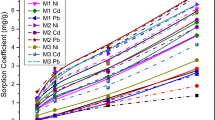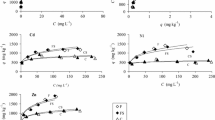Abstract
Investigating the interactions of heavy metals is imperative for sustaining environment and human health. Among those, Cd is toxic for organisms at any concentration. While Ni acts as a micronutrient at very low concentration but is hazardous toxic above certain threshold value. In this study, the chemical adsorption and desorption reactions of Ni and Cd in contaminated soils were investigated in both single and binary ion systems. Both Ni and Cd experimental data demonstrated Langmuir type adsorption. In the competitive systems, an antagonistic effect was observed, implying that both ions compete for same type of adsorption sites. Adverse effect of Cd on Ni adsorption was slightly stronger than that of opposite system, consistent with adsorption isotherms in single ion systems. Variation in ionic strength indicated that Ca, a much weaker adsorbate, could also compete with Cd and Ni for adsorption on soil particles. Desorption data indicated that Cd and Ni are adsorbed very tightly such that after four successive desorption steps, less than 0.5 % of initially adsorbed ions released into the soil solution. This implies that Ca, at concentration in equilibrium with calcite mineral, cannot adequately compete with and replace adsorbed Ni and Cd ions. This adsorption behavior was led to considerable hysteresis between adsorption and desorption in both single and binary ion systems. In the binary ion systems, desorption of Cd and Ni was increased by increase in both equilibrium concentration of adsorbed ion and concentration of competitor ion. The overall results obtained in this research indicate that Cd and Ni are strongly adsorbed in calcareous soil and Ca, the major dissolved ion, insignificantly influences metal ions adsorption. Consequently, the contaminated soils by Ni and Cd can simultaneously be remediated by environmentally oriented technologies such as phytoremediation.





Similar content being viewed by others
References
Amacher MC, Selim HM, Iskandar IK (1990) Kinetics of mercuric-chloride retention by soils. J Environ Qual 19:382–388
Anderson PR, Christensen TH (1988) Distribution coefficients of Cd, Co, Ni, and Zn in soils. J Soil Sci 39:15–22
Asadi Kapourchal S, Asadi Kapourchal S, Pazira E, Homaee M (2009) Assessing radish (Raphanus sativus L.) potential for phytoremediation of lead-polluted soils resulting from air pollution. Plant Soil Environ 55:202–206
Asadi Kapourchal S, Lazarjan SE, Homaee M (2011) Phytoremediation of cadmium polluted soils from phosphorus fertilizers. Curr Opin Biotechnol 22(Supplement 1):S37
Atafar Z, Mesdaghinia A, Nouri J, Homaee M, Yunesian M, Ahmadimoghaddam M, Mahvi AH (2010) Effect of fertilizer application on soil heavy metal concentration. Environ Monit Assess 160:83–89
Atanassova ID (1995) Adsorption and desorption of Cu at high equilibrium concentrations by soil and clay samples from Bulgaria. Environ Pollut 87:17–21
Chen HM, Zheng CR, Tu C, Shen ZG (2000) Chemical methods and phytoremediation of soil contaminated with heavy metals. Chemosphere 41:229–234
Covelo EF, Vega FA, Andrade ML (2007) Simultaneous sorption and desorption of Cd, Cr, Cu, Ni, Pb, and Zn in acid soils I. selectivity sequences. J Hazard Mater 147:852–861
Covelo EF, Vega FA, Andrade ML (2008) Sorption and desorption of Cd, Cr, Cu, Ni, Pb and Zn by a fibric histosol and its organo-mineral fraction. J Hazard Mater 159:342–347
Davari M, Homaee M, Rahnemaie R (2015) An analytical deterministic model for simultaneous phytoremediation of Ni and Cd from contaminated soils. Environ Sci Pollut Res 22:4609–4620
de Souza Braz A, Fernandes A, Ferreira J, Alleoni L (2013): Distribution coefficients of potentially toxic elements in soils from the eastern Amazon. Environ Sci Pollut Res 20:7231–7242
Fawzy EM (2008) Soil remediation using in situ immobilisation techniques. Chem Ecol 24:147–156
Filius A, Streck T, Richter J (1998) Cadmium sorption and desorption in limed topsoils as influenced by pH: isotherms and simulated leaching. J Environ Qual 27:12–18
Fontes M, Santos G (2010) Lability and sorption of heavy metals as related to chemical, physical, and mineralogical characteristics of highly weathered soils. J Soils Sediments 10:774–786
Gao S, Walker W, Dahlgren R, Bold J (1997) Simultaneous sorption of Cd, Cu, Ni, Zn, Pb, and Cr on soils treated with sewage sludge supernatant. Water Air Soil Pollut 93:331–345
Gomes PC, Fontes MPF, da Silva AG, Mendonca ED, Netto AR (2001) Selectivity sequence and competitive adsorption of heavy metals by Brazilian soils. Soil Sci Soc Am J 65:1115–1121
Harter RD (1992) Competitive sorption of cobalt, copper, and nickel ions by a calcium-saturated soil. Soil Sci Soc Am J 56:444–449
Helios-Rybicka E, Wójcik R (2012) Competitive sorption/desorption of Zn, Cd, Pb, Ni, Cu, and Cr by clay-bearing mining wastes. Appl Clay Sci 65–66:6–13
Jafarnejadi AR, Homaee M, Sayyad G, Bybordi M (2011) Large scale spatial variability of accumulated cadmium in the wheat farm grains. Soil Sediment Contam 20:98–113
Jafarnejadi AR, Sayyad G, Homaee M, Davamei AH (2013) Spatial variability of soil total and DTPA-extractable cadmium caused by long-term application of phosphate fertilizers, crop rotation, and soil characteristics. Environ Monit Assess 185:4087–4096
Jalali M, Moradi F (2013) Competitive sorption of Cd, Cu, Mn, Ni, Pb and Zn in polluted and unpolluted calcareous soils. Environ Monit Assess 185:8831–8846
Jing YD, He ZL, Yang XE (2008) Adsorption-desorption characteristics of mercury in paddy soils of China. J Environ Qual 37:680–688
Khodaverdiloo H, Homaee M (2008) Modeling of cadmium and lead phytoextraction from contaminated soils. Pol J Soil Sci 41:149–162
Kinniburgh DG (1986) General purpose adsorption isotherms. Environ Sci Technol 20:895–904
Kinniburgh DG (1993) Fit user guide, technical report WD/93/23, British Geological Survey
Klute A (1986) Methods of soil analysis. Part 1. ASA, SSSA Inc, Madison
Liao LX, Selim HM (2009) Competitive sorption of nickel and cadmium in different soils. Soil Sci 174:549–555
Mahmoudi M, Rahnemaie R, Es-haghi A, Malakouti MJ (2013) Kinetics of degradation and adsorption–desorption isotherms of thiobencarb and oxadiargyl in calcareous paddy fields. Chemosphere 91:1009–1017
Majidi A, Rahnemaie R, Hassani A, Malakouti MJ (2010) Adsorption and desorption processes of boron in calcareous soils. Chemosphere 80:733–739
Manzoori JL, Karim-Nezhad G (2004) Development of a cloud point extraction and preconcentration method for Cd and Ni prior to flame atomic absorption spectrometric determination. Anal Chim Acta 521:173–177
Misono M, Ochiai E, Saito Y, Yoneda Y (1967) A new dual parameter scale for the strength of Lewis acids and bases with the evaluation of their softness. J Inorg Nucl Chem 29:2685–2691
Muyssen BTA, Brix KV, DeForest DK, Janssen CR (2004) Nickel essentiality and homeostasis in aquatic organisms. Environ Rev 12:113–131
O’connor GA, O’connor C, Cline GR (1984) Sorption of cadmium by calcareous soils: influence of solution composition. Soil Sci Soc Am J 48:1244–1247
Page AL, Miller RH, Keeney DR (1982) Methods of soil analysis, Part 2. ASA, SSSA Inc, Madison
Pearson RG (1963) Hard and soft acids and bases. J Am Chem Soc 85:3533–3539
Pinheiro JP, Mota AM, Benedetti MF (1999) Lead and calcium binding to fulvic acids: salt effect and competition. Environ Sci Technol 33:3398–3404
Reddy MR, Dunn SJ (1986) Distribution coefficients for nickel and zinc in soils. Environ Pollut B 11:303–313
Saha UK, Taniguchi S, Sakurai K (2002) Simultaneous adsorption of cadmium, zinc, and lead on hydroxyaluminum- and hydroxyaluminosilicate-montmorillonite complexes. Soil Sci Soc Am J 66:117–128
Sen Gupta S, Bhattacharyya KG (2006) Adsorption of Ni(II) on clays. J Colloid Interface Sci 295:21–32
Serrano S, Garrido F, Campbell CG, Garcia-Gonzalez MT (2005) Competitive sorption of cadmium and lead in acid soils of Central Spain. Geoderma 124:91–104
Shuto R (2005) Itai-Itai. In: Philip W (ed) Encyclopedia of toxicology, 2nd edn. Elsevier, New York, pp 655–656
Singh SS (1979) Sorption and release of cadmium some Canadian soils. Can J Soil Sci 59:119–130
Sparks DL (1999) Soil physical chemistry. CRC Press, Boca Raton, 409 p. pp
Usman ARA (2008) The relative adsorption selectivities of Pb, Cu, Zn, Cd and Ni by soils developed on shale in New Valley, Egypt. Geoderma 144:334–343
Wuana RA, Okieimen FE (2011) Heavy metals in contaminated soils: a review of sources, chemistry, risks and best available strategies for remediation. ISRN Ecol 2011:20
Yin YJ, Allen HE, Huang CP, Sanders PF (1997) Adsorption/desorption isotherms of Hg(II) by soil. Soil Sci 162:35–45
Conflict of interest
The authors of this manuscript have no potential conflict of interest.
Author information
Authors and Affiliations
Corresponding author
Additional information
Responsible editor: Michael Matthies
Rights and permissions
About this article
Cite this article
Davari, M., Rahnemaie, R. & Homaee, M. Competitive adsorption-desorption reactions of two hazardous heavy metals in contaminated soils. Environ Sci Pollut Res 22, 13024–13032 (2015). https://doi.org/10.1007/s11356-015-4505-8
Received:
Accepted:
Published:
Issue Date:
DOI: https://doi.org/10.1007/s11356-015-4505-8




